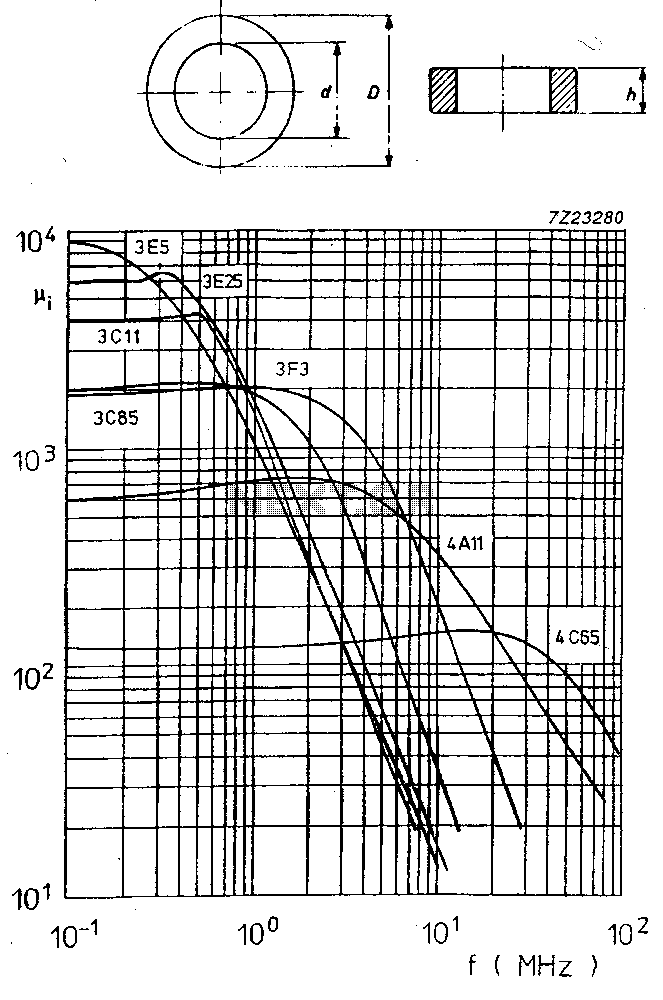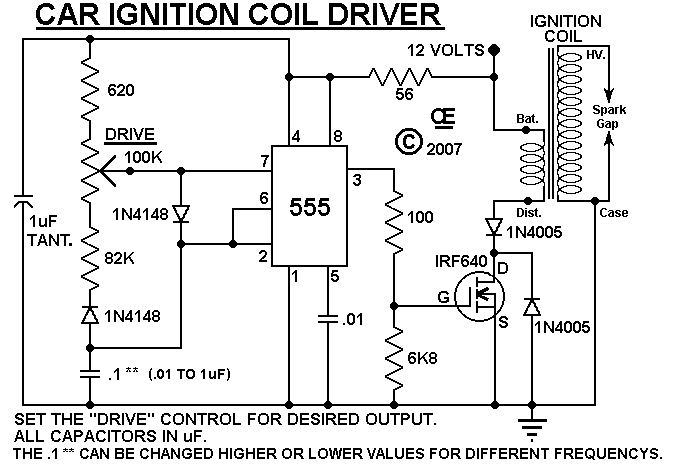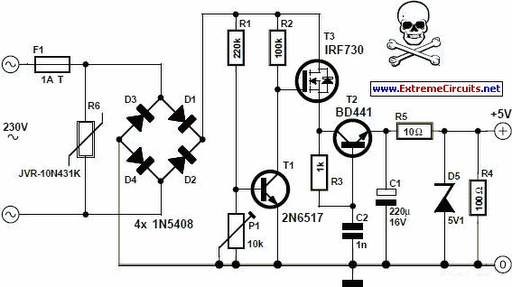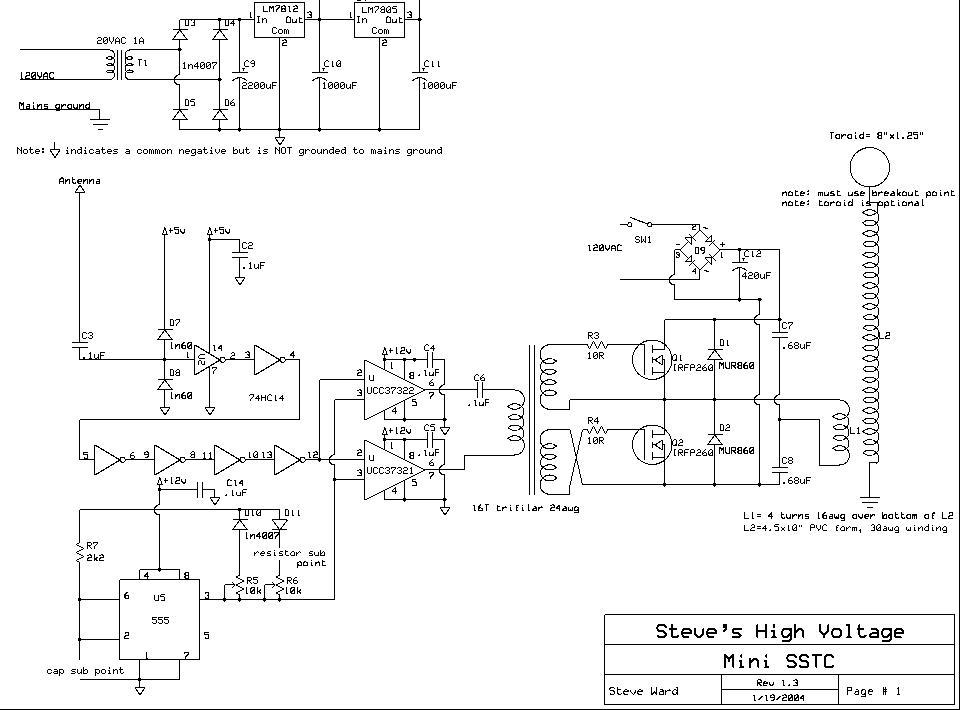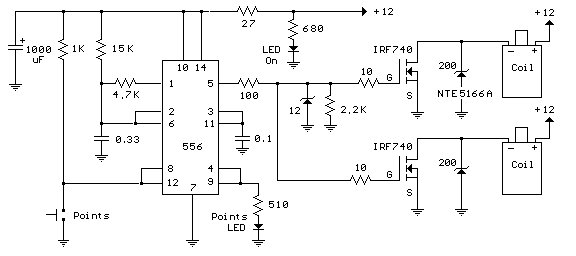
A transformerless Tesla coil
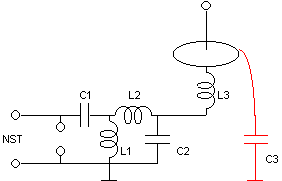
Continuing the studies on directly coupled multiple resonance networks operated as Tesla coil-like devices, a 6th-order system was constructed that is equivalent to a "Tesla magnifier," but without a transformer. The schematic diagram is provided. This circuit has several potential advantages over a simpler directly coupled Tesla coil: faster energy transfer from C1 to the distributed terminal capacitance C3, resulting in smaller losses, greater efficiency, and insensitivity to tuning precision. The wider notches in the primary waveforms tend to cause rapid quenching of the spark gap at the first notch, trapping all the energy in the high-voltage part of the circuit. The design is limited by the absence of the extra degree of freedom allowed by a transformer in the classic magnifier circuit, with the maximum voltage gain constrained by the ratios among the resonance frequencies; however, the transformerless construction is simpler. The system was designed to have three resonance frequencies in the ratio of 5:6:7. This configuration enables the energy transfer from C1 to C3, neglecting losses, in just three cycles (12.5 µs), compared to the 11 cycles (37.6 µs) required by the 4th-order directly coupled system with identical input and output capacitances. The power supply is a 5000 V, 30 mA neon sign transformer with a single floating output that charges capacitor C1, which is then discharged through a multiple spark gap initiating the energy transfer transient. C1 is a 5.09 nF "MMC" capacitor, the same used with the 4th-order system. L3, the output resonator coil with 28.2 mH, the terminal with a telescopic antenna, the NST, and the spark gap are also identical. Their descriptions are available elsewhere. The other two coils are L1, with 87 µH, constructed with 42 turns of insulated 1 mm² wire over an 8.8 cm PVC tube, and L2, with 1521 µH, made with 257 turns of #18 magnet wire, also over a PVC tube. C2 is a flat plate high-voltage capacitor that achieved optimal tuning with the other elements at 257 pF. No filters or special protection circuits were incorporated, as the power levels are not high. The ground connection is made to a metal bucket buried in the ground. The components are arranged on a table, interconnected with flexible wires with terminals at the ends, connected via brass screws and nuts mounted on the elements. Insulating supports are placed beneath the floating elements. Initially, C2 was an adjustable capacitor constructed with a PVC tube featuring a fixed inner plate of aluminum foil and an adjustable outer plate. This design performed well at low power; however, at full power, it produced significant corona discharge and progressive capacitance changes due to surface deterioration of the PVC, likely from metal deposition, which increased the capacitance and detuned the system. Attempts to enhance insulation by applying wax around the edges of the plates failed due to punctures. A new capacitor was constructed using two flat plates glued to an acrylic plate, with terminals fixed to the plates, designed to yield 247 pF. Due to an oversight regarding the fringe field at the edges of a test capacitor used to determine the dielectric constant of the acrylic plate, the resulting capacitance was smaller, at 211 pF. It was noted that corona discharge around the plates would increase the effective capacitance by approximately the correct amount, and the capacitor functioned effectively. Insulation improvements were not pursued during initial tests, and the plates would need to be slightly larger without the corona discharge. The performance achieved was somewhat superior to that of the 4th-order system, as evidenced by the presence of streamers emanating not only from the terminal antenna but also from the disk at the base of the terminal. Additionally, a corona haze was observed around the terminal.
The circuit described operates by utilizing a transformerless design that leverages multiple resonance frequencies to enhance energy transfer efficiency. The arrangement of capacitors, inductors, and the spark gap plays a crucial role in the performance of the system. The choice of components, such as the specific values of inductance and capacitance, is critical in achieving the desired resonance conditions. The use of a neon sign transformer as a power supply is appropriate for generating the high voltages required for operation while maintaining manageable current levels. The flexible wiring and mechanical connections allow for easy modifications and adjustments during experimentation. The grounding method employed provides a necessary safety feature while maintaining circuit functionality. Overall, this circuit exemplifies innovative approaches to Tesla coil design, focusing on efficiency and simplicity without compromising performance.Continuing the studies about directly coupled multiple resonance networks operated as Tesla coil like devices, I built a 6th-order system, that is equivalent to a " Tesla magnifier ", but without a transformer. The schematic diagram is shown below: This circuit has several potential advantages over a simpler directly coupled Tesla coil : Faster en
ergy transfer from C1 to the distributed terminal capacitance C3, what results in smaller losses, greater efficiency, and insensitivity to tuning precision. The wider notches in the primary waveforms tend to cause fast quenching of the spark gap, at the first notch, trapping all the energy in the high-voltage part of the circuit.
The design is restricted by the absence of the extra degree of freedom allowed by a transformer in the classic magnifier circuit, with the maximum voltage gain being forced by the ratios among the resonance frequencies, but the transformerless construction is simpler. The system was designed to have three resonance frequencies, in the ratio 5:6:7. In this way it can transfer the energy in C1 to C3, ignoring losses, in just three cycles (in 12. 5 µs), instead of in the 11 cycles (in 37. 6 µs) required by the 4th-order directly coupled system with the same input (identical) and output (almost identical) capacitances.
The power supply is a 5000 V, 30 mA neon sign transformer with a single floating output, that charges the capacitor C1, that is then discharged through a multiple spark gap starting the energy transfer transient. C1 is a 5. 09 nF "MMC" capacitor, the same that I used with the 4th-order system. L3, the output resonator coil with 28. 2 mH, the terminal with a telescopic antenna, the NST and the spark gap are also the same. Their description can be seen here. The other two coils are L1, with 87 µH, made with 42 turns of insulated 1 mm2 wire over an 8. 8 cm PVC tube, and L2, with 1521 µH, made with 257 turns of #18 magnet wire, also over a PVC tube. C2 is a flat plate high-voltage capacitor, that produced the best tuning with the other elements with 257 pF.
No filters or special protection circuits were included, since the power is not high. The ground connection goes to just a metal bucket in the ground. The components are simply disposed over a table, interconnected with flexible wires with terminals at the ends, between brass screws and nuts mounted in the elements. Insulating supports are inserted below the floating elements. C2 was, in a first attempt, an adjustable capacitor made with a PVC tube having a fixed inner plate of aluminum foil and an adjustable outer plate.
Worked well at low power, but when in operation at full power the construction resulted in a lot of corona, and progressive capacitance change due to surface deterioration of the PVC, probably with metal deposition, that increased the capacitance and detuned the system. When I tried to improve the insulation by applying wax around the edges of the plates, it failed almost immediately with a puncture.
A new capacitor was then made with simply two flat plates glued to an acrylic plate, in contact with terminals fixed to the plates, with the dimensions calculated to result in 247 pF. But due to an error (I disconsidered the fringe field at the borders of a test capacitor made to determine the dielectric constant of the acrilic plate) it resulted smaller, with 211 pF.
I realized, however, that corona around the plates would increase the effective capacitance by approximately the correct amount. The capacitor worked well. I didn`t try to improve its insulation in the first tests (and the plates would have to be a little larger without the corona).
The obtained performance was somewhat better than with the 4th-order system, a fact evidenced by the presence of streamers coming not only from the terminal antenna, but also from the disk at the base of the terminal. It also produces a kind of corona haze around the terminal that 🔗 External reference
The circuit described operates by utilizing a transformerless design that leverages multiple resonance frequencies to enhance energy transfer efficiency. The arrangement of capacitors, inductors, and the spark gap plays a crucial role in the performance of the system. The choice of components, such as the specific values of inductance and capacitance, is critical in achieving the desired resonance conditions. The use of a neon sign transformer as a power supply is appropriate for generating the high voltages required for operation while maintaining manageable current levels. The flexible wiring and mechanical connections allow for easy modifications and adjustments during experimentation. The grounding method employed provides a necessary safety feature while maintaining circuit functionality. Overall, this circuit exemplifies innovative approaches to Tesla coil design, focusing on efficiency and simplicity without compromising performance.Continuing the studies about directly coupled multiple resonance networks operated as Tesla coil like devices, I built a 6th-order system, that is equivalent to a " Tesla magnifier ", but without a transformer. The schematic diagram is shown below: This circuit has several potential advantages over a simpler directly coupled Tesla coil : Faster en
ergy transfer from C1 to the distributed terminal capacitance C3, what results in smaller losses, greater efficiency, and insensitivity to tuning precision. The wider notches in the primary waveforms tend to cause fast quenching of the spark gap, at the first notch, trapping all the energy in the high-voltage part of the circuit.
The design is restricted by the absence of the extra degree of freedom allowed by a transformer in the classic magnifier circuit, with the maximum voltage gain being forced by the ratios among the resonance frequencies, but the transformerless construction is simpler. The system was designed to have three resonance frequencies, in the ratio 5:6:7. In this way it can transfer the energy in C1 to C3, ignoring losses, in just three cycles (in 12. 5 µs), instead of in the 11 cycles (in 37. 6 µs) required by the 4th-order directly coupled system with the same input (identical) and output (almost identical) capacitances.
The power supply is a 5000 V, 30 mA neon sign transformer with a single floating output, that charges the capacitor C1, that is then discharged through a multiple spark gap starting the energy transfer transient. C1 is a 5. 09 nF "MMC" capacitor, the same that I used with the 4th-order system. L3, the output resonator coil with 28. 2 mH, the terminal with a telescopic antenna, the NST and the spark gap are also the same. Their description can be seen here. The other two coils are L1, with 87 µH, made with 42 turns of insulated 1 mm2 wire over an 8. 8 cm PVC tube, and L2, with 1521 µH, made with 257 turns of #18 magnet wire, also over a PVC tube. C2 is a flat plate high-voltage capacitor, that produced the best tuning with the other elements with 257 pF.
No filters or special protection circuits were included, since the power is not high. The ground connection goes to just a metal bucket in the ground. The components are simply disposed over a table, interconnected with flexible wires with terminals at the ends, between brass screws and nuts mounted in the elements. Insulating supports are inserted below the floating elements. C2 was, in a first attempt, an adjustable capacitor made with a PVC tube having a fixed inner plate of aluminum foil and an adjustable outer plate.
Worked well at low power, but when in operation at full power the construction resulted in a lot of corona, and progressive capacitance change due to surface deterioration of the PVC, probably with metal deposition, that increased the capacitance and detuned the system. When I tried to improve the insulation by applying wax around the edges of the plates, it failed almost immediately with a puncture.
A new capacitor was then made with simply two flat plates glued to an acrylic plate, in contact with terminals fixed to the plates, with the dimensions calculated to result in 247 pF. But due to an error (I disconsidered the fringe field at the borders of a test capacitor made to determine the dielectric constant of the acrilic plate) it resulted smaller, with 211 pF.
I realized, however, that corona around the plates would increase the effective capacitance by approximately the correct amount. The capacitor worked well. I didn`t try to improve its insulation in the first tests (and the plates would have to be a little larger without the corona).
The obtained performance was somewhat better than with the 4th-order system, a fact evidenced by the presence of streamers coming not only from the terminal antenna, but also from the disk at the base of the terminal. It also produces a kind of corona haze around the terminal that 🔗 External reference
